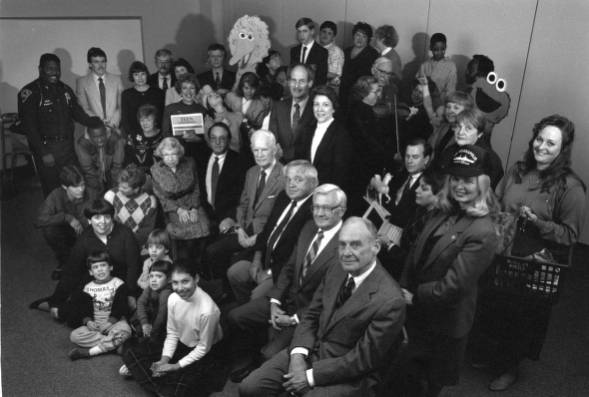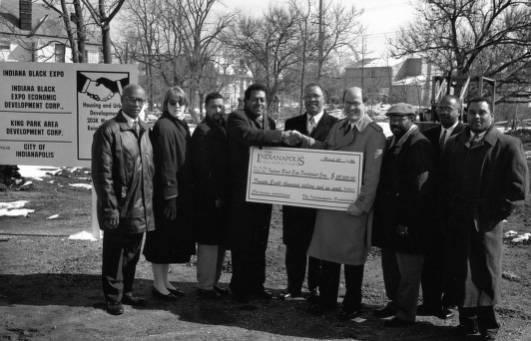Principal founders Evans Woollen, president of , and Henry H. Hornbrook, an Indianapolis attorney, initiated the January 5, 1915, resolution of trust that created the Indianapolis Foundation, a publicly supported philanthropic institution to promote the welfare of residents of Indianapolis. The three original trust companies were the Fletcher Savings and Trust Company, the Indiana Trust Company, and the . Founding trustees included , , Louis H. Levy, Francis H. Gavisk, Henry W. Bennett, and Henry H. Hornbrook. replaced Charles W. Fairbanks as a trustee in 1918 and became the seminal figure and leader of the foundation until 1946.

Cleveland, Ohio, established the first community foundation in 1914 as a mechanism to free philanthropic interests from the “dead hand” that governed outmoded or overly restricted private trust funds. Evans Woollen Sr., president of the Fletcher Savings and Trust Company and a friend of Goff, brought the idea to Indianapolis the next year, making the Indianapolis Foundation among the earliest community foundations in the country. It also was the first to utilize the multiple trusteeship concept whereby several banks and trust companies adopt the same resolution of trust and receive and administer gifts and bequests to generate investment income. The trustee banks then made the income available for charitable distribution in the form of grants.
While the trustee banks administer funds to generate income, a six-member board of trustees comprised of private citizens determines how this income is to be expended. These private citizens are chosen for their knowledge about the community and their ability to represent the public interest. They serve six-year terms without compensation, and they may be reappointed. Two appointments each are made by the mayor of Indianapolis, the judge of the Marion Circuit Court, and the federal court judges exercising jurisdiction over the Southern District of Indiana. The board of trustees meets five or six times a year to consider grant requests and to determine Foundation policies.
The original mission restricted the use of the Indianapolis Foundation income from trust funds for such charitable purposes that would, in the judgment of the Trustees promote the welfare of people residing in Indianapolis (). Other than the geographic limitation there were few restrictions governing the expenditure of income.
The foundation issued its first grant in 1924 to the Public Health Nursing Association for a nurse for children with disabilities. In 1927, The Indianapolis Foundation commissioned a major study on the importance of parks to the health and welfare of the city. This study led to major investments in the park system in Indianapolis. The Indianapolis Foundation was an early funder if not the first funder for many major not-for-profits that make up the Indianapolis charitable sector in 2020.
The foundation makes grants only to not-for-profit organizations, not to individuals, or for sectarian or religious purposes. Because the foundation has a higher percentage of unrestricted funds than any other community foundation, its board of trustees has the flexibility to direct the foundation’s resources to the most urgent community needs.
In 1987, the foundation adopted a mission statement that commits them to mobilize people, ideas, and investments to help make Indianapolis a community where all individuals have an equitable opportunity to reach their full potential, regardless of place, race, or identity. The change in the mission statement provided donors a way to help “where the needs are greatest, and the benefits…most substantial,” as changing conditions dictate.

The William E. English Foundation is a support organization to the Indianapolis Foundation. It was organized in 1932 to carry out provisions in will for a facility to house community service agencies. In 1953, it opened the English Foundation Building at 615 North Alabama Street, which houses tenant agencies on a shared maintenance cost basis that results in substantial savings over commercial office space rates. At the time of its construction, the building was the largest structure anywhere specifically designed to house community service agencies. The English Foundation’s sole purpose is the ownership and operation of the building. It does not make financial grants. The English Foundation is governed by a nine-member board of directors, six of whom serve concurrently as trustees of the Indianapolis Foundation. The English Foundation also shares offices and staff with Indianapolis Foundation, enabling each foundation to operate at lower costs than would otherwise be possible.
The Indianapolis Foundation moved from its Hume-Mansur Building location to 615 N. Alabama Street, Suite 300, after the former building was sacrificed in 1980 to make way for the Bank One tower, known as the in 2020.
Since its founding in 1915, the Indianapolis Foundation has given hundreds of millions of dollars to Indianapolis not-for-profits and has provided civic leadership to the city’s human services, education, and libraries, arts and culture, community development, economic development, and , and recreation sectors. Among organizations that have received major grants are , , , , (the scholarship fund), Indianapolis Senior Citizens Center, , Marion County library services, and .
The Indianapolis Foundation partnered with the Hamilton County Community Foundation in 1997 to form the .

Help improve this entry
Contribute information, offer corrections, suggest images.
You can also recommend new entries related to this topic.